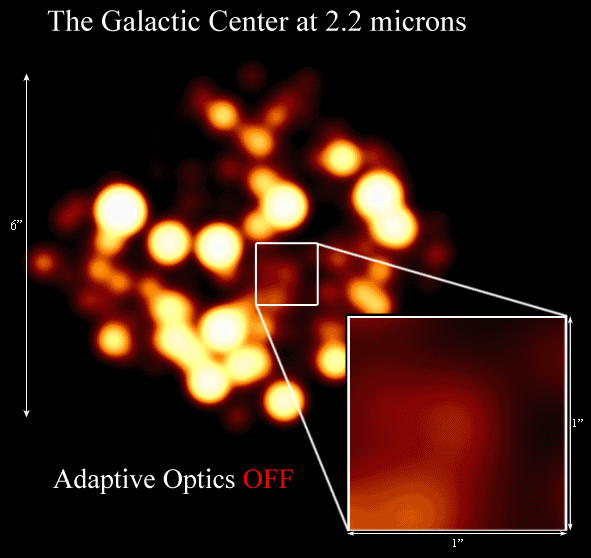Animation
All animations are credited to and referenced by the UCLA Galactic Center Group and the W.M. Keck Observatory Laser Team, except where indicated. Image creators include Andrea Ghez, Sylvana Yelda, Leo Meyer, Jessica Lu, Seth Hornstein, Tuan Do, Shoko Sakai, Aurelien Hees and Angelle Tanner. These animations are available for Educational and Professional use, may be freely used.However, it is requested that any use of this work be reported to the UCLA Galactic Center Group - Contact and given the following acknowledgement: "These images/animations were created by Prof. Andrea Ghez and her research team at UCLA and are from data sets obtained with the W. M. Keck Telescopes."
Stellar Orbits in the Central Parsec
An animation of the stellar orbits spanning 30 years in the central 0.5 arcsec. Images taken from the years 1995 through 2025 are used to track specific stars orbiting the proposed black hole at the center of the Galaxy.
These orbits, and a simple application of Kepler's Laws, provide the best evidence yet for a supermassive black hole, which has a mass of 4 million times the mass of the Sun.
Especially important is the star S0-2 as it has has been observed for more than one full orbital period, which is only 16.17 years.
3D Movie of Stellar Orbits in the Central Parsec
Stellar orbits that have revealed the existence of a supermassive black hole that is 4 million times the mass of the sun and that lies at the center of the Galaxy ~25,000 light years away. The Galactic center also plays host to an unexpected population of young, massive stars, whose orbits can provide insight into their origin as well as the hostile environment surrounding a supermassive black hole.
The movie shows a 3-dimensional visualization of the stellar orbits in the Galactic center based on data obtained by the W. M. Keck Telescopes between 1995 and 2012. Stars with the best determined orbits are shown with full ellipses and trails behind each star span ~15-20 years. These stars are color-coded to represent their spectral type: Early-type (young) stars are shown in teal green, late-type (old) stars are shown in orange, and those with unknown spectral type are shown in magenta.
Stars without ellipses are from a statistical sample and follow the observed radial distributions for the early (white) or late (yellow/orange) type stars. These stars are embedded in a model representation of the inner Milky Way provided by NCSA/AVL to provide context for the visualization.
The movie begins at the very center of the Galaxy, ~0.015 pc from the supermassive black hole, in the year 1893, and pulls a way to a distance of 0.2 pc as the movie reaches the year 2013, ending from the viewing angle of Earth.
Interesting things to notice: Observations of the Galactic center have revealed two paradoxes: there are far fewer old stars and many more young stars than expected based on theories. Stars in the central ~0.04 pc (1'') are on randomly distributed orbits. Just outside the central arcsecond, there are many young stars orbiting the supermassive black hole in a common plane. These stars likely formed in a massive, gaseous disk in the central parsec.
This movie is copyrighted by the University of Illinois and is available for academic and educational purposes only. Credits integrated within the movie are required for its use. For any broadcast or commercial use of this movie, please contact , University of Illinois NCSA Advanced Visualization Laboratory.
NIRC2: Stellar Orbits
Images at 2.2 microns taken of the center of the galaxy with the W. M. Keck Telescopes on Mauna Kea are used to make this animation. The images are aligned at the position of Sgr A*, located in the center of the images.
Sgr A* is the radio counterpart associated with the supermassive black hole at the center of the galaxy. The star S0-2 went through its closest approach to the black hole in 2018, and it and its measured orbit are labeled in the images.
Sgr A*-IR
This three color animation, centered on Sgr A*-IR shows, for the first time ever, the broadband color of Sgr A*-IR throughout an outburst. The image is 1 arcsec on a side and covers about two hours of observations. For this false color animation, H (1.8 microns) = blue, K' (2.1 microns) = green, and L' (3.8 microns) = red.
The animation was created from data obtained at the W. M. Keck Observatory using the Laser Guide Star Adaptive Optics System.
Resolution in the Central 0.5” of the Future Thirty-Meter Telescope
Animation showing the improvement in resolution in the central 0.5” of the Galaxy from seeing-limited to Keck + Adaptive Optics to future Extremely Large Telescopes + Adaptive Optics. Actual orbits are shown in the seeing-limited and Keck cases, while additional simulated orbits are included for the ELT case. See a side-by-side comparison in the 3-panel animation.
To view the RA offset from Sgr A* in detail, click bottom left icon to enlarge the animation.
Adaptive Optics

This animation shows observations of the Galactic Center with and without Adaptive Optics, illustrating the resolution gain. Adaptive optics corrects for the blurring effects of the Earth's atmosphere. Using a bright star, we measure how a wavefont of light is distorted by the atmosphere and quickly adjust the shape of a deformable mirror to remove these distortions.